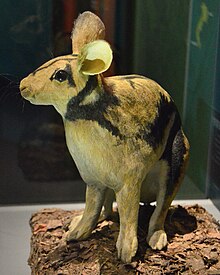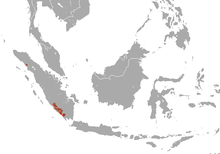
Mount Kerinci is an active stratovolcano and the highest mountain in Sumatra, Indonesia. At 12,484 ft (3,805 m) above sea level, it provides Sumatra with the fifth-highest maximum elevation of any island in the world. It is surrounded by the lush forest of Kerinci Seblat National Park, home to several endangered species including the Sumatran tiger. Mount Kerinci is ranked 32nd by topographic isolation.

The Sumatran tiger is a population of Panthera tigris sondaica on the Indonesian island of Sumatra. It is the only surviving tiger population in the Sunda Islands, where the Bali and Javan tigers are extinct.

Gunung Leuser National Park is a national park covering 7,927 km2 in northern Sumatra, Indonesia, straddling the border of Aceh and North Sumatra provinces, a fourth portion and three-fourths portion, respectively. The national park, settled in the Barisan mountain range, is named after Mount Leuser (3,119 m), and protects a wide range of ecosystems. An orangutan sanctuary at Bukit Lawang is located within the park. Together with Bukit Barisan Selatan and Kerinci Seblat National Parks, it forms a World Heritage Site, the Tropical Rainforest Heritage of Sumatra.
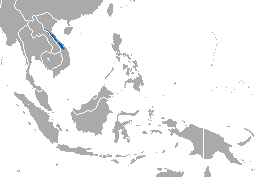
The Annamite striped rabbit is a species of rabbit native to the Annamite mountain range on the Laos-Vietnam border. The rabbit is striped, with a red rump, and resembles the Sumatran striped rabbit. It only recently became known to Western scientists: striped rabbits were first observed in 1996 by biologist Rob Timmins in a market in Bak Lak in Laos, and the species was described in 2000 and named after Timmins' find.
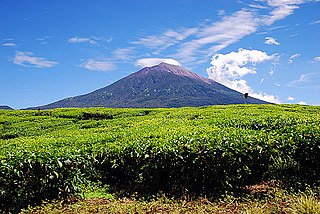
Kerinci Seblat National Park is the largest national park on the island of Sumatra, Indonesia. It has a total area of 13,791 km2 and spans four provinces: West Sumatra, Jambi, Bengkulu, and South Sumatra.
The Tropical Rainforest Heritage of Sumatra site was inscribed as a UNESCO World Heritage Site in 2004. It comprises three Indonesian national parks on the island of Sumatra: Gunung Leuser National Park, Kerinci Seblat National Park and the Bukit Barisan Selatan National Park. The site is listed under Criteria vii - outstanding scenic beauty; ix- an outstanding example representing significant on-going ecological and biological processes; and x- contains the most important and significant natural habitats for in-situ conservation. The Tropical Rainforest Heritage of Sumatra has been placed on the Danger List since 2011 to help overcome threats posed by poaching, illegal logging, agricultural encroachment, and plans to build roads through the site.

The Sumatran ground cuckoo is a large, terrestrial species of cuckoo. It was introduced to Western science in 1879 and was formerly considered conspecific with the Bornean ground cuckoo but was given status as a unique species in 2000. This elusive species was initially known from just eight specimens and evaded notice from 1916 until 1997, when it was rediscovered and photographed by Andjar Rafiastanto. The Sumatran ground cuckoo's diet is thought to consist of invertebrates, small mammals, and reptiles.

Bukit Barisan Selatan National Park is a national park in Sumatra, Indonesia. The park located along the Bukit Barisan mountain range, has a total area of 3,568 km2, and spans three provinces: Lampung, Bengkulu, and South Sumatra. Together with Gunung Leuser and Kerinci Seblat national parks it forms a World Heritage Site, Tropical Rainforest Heritage of Sumatra.

The Sunda clouded leopard is a medium-sized wild cat native to Borneo and Sumatra. It is listed as Vulnerable on the IUCN Red List since 2015, as the total effective population probably consists of fewer than 10,000 mature individuals, with a decreasing population trend. On both Sunda Islands, it is threatened by deforestation. It was classified as a separate species, distinct from the clouded leopard in mainland Southeast Asia based on a study in 2006. Its fur is darker with a smaller cloud pattern.
The Sumatran shrewlike mouse is a species of mouse. It is endemic to Indonesia.
Wijayarana modiglianii is a species of frog in the family Ranidae. It is endemic to Sumatra (Indonesia). It was originally only known from two locations near Lake Toba, but is now known to be more widespread. The specific name modiglianii honors Elio Modigliani, an Italian anthropologist and zoologist who collected the holotype in 1891. Common name Modigliani's huia frog has been coined for this species. Morphological evidence suggests that it can hybridize with Huia sumatrana, but this needs confirmation using genetic data.
The Sumatran muntjac is a subspecies of Indian muntjac in the deer family which can be the size of a large dog. It was discovered in 1914, but had not been sighted since 1930 until one was snared and freed from a hunter's snare in Kerinci Seblat National Park, Sumatra, Indonesia in 2002. Two other Sumatran muntjac have since been photographed in the park. The Sumatran muntjac was placed on the IUCN Red List in 2008, but was listed as Data Deficient, as taxonomic issues are still unresolved. The distribution of the taxon is also uncertain and may be more extensive than suggested. It is possible that some previous sightings of the common muntjac in Western Sumatra were the Sumatran muntjac.

Nesolagus is a genus of rabbits containing three species of striped rabbit: the Annamite striped rabbit, the Sumatran striped rabbit, and the extinct species N. sinensis. Overall there is very little known about the genus as a whole, most information coming from the Sumatran rabbit.
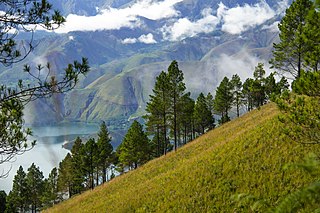
The Sumatran tropical pine forests is a tropical coniferous forest ecoregion on the island of Sumatra in Indonesia.

The Sumatran clouded leopard is a subspecies of the Sunda clouded leopard and is native to the Indonesian islands of Sumatra and Batu. It differs in molecular, craniomandibular and dental characteristics from the Bornean clouded leopard. It was recognized as a valid subspecies in 2017.

The Sumatran lowland rain forests ecoregion covers the lowland forests running the length of the island of Sumatra in Indonesia. The region is one of exceptionally high biodiversity, similar to Borneo and New Guinea islands. Many endangered mammals species are present, and over 450 species of birds have been found in the region. In recent years, illegal logging and human encroachment have put great strain on this ecoregion.

The Sumatran montane rain forests ecoregion covers the mountainous elevations of the Barisan Mountains Range that runs the length of the southwestern side of the island of Sumatra in Indonesia. The ecoregion is almost completely surrounded by the lower elevation Sumatran lowland rain forests. The area is one of very high biodiversity - because of the relative isolation, and variety of forest types, there are 7 endemic species of mammals and eight endemic species of birds.
The Sumatran hog badger is a species of mustelid endemic to the island of Sumatra in Indonesia.

The western Sumatran rhinoceros is a subspecies of the Sumatran rhinoceros that is native to Sumatra, primarily within these Indonesian national parks: Bukit Barisan Selatan National Park, Kerinci Seblat National Park, Mount Leuser National Park, and its population is partially remaining in Way Kambas National Park. The subspecies went extinct in the Malaysian Peninsula. Its population is limited, with only around 275 rhinos left in the wild, from which they are being threatened by poaching, and occasional habitat loss. A few individuals are being held and bred in captivity within the Sumatran Rhino Sanctuary, and in the Cincinnati Zoo and Botanical Garden.

Isau-Isau Wildlife Reserve is a nature reserve in South Sumatra, Indonesia. It is home to a large number of species, many of which are threatened or endangered. Formerly protected as Isau-Isau Pasemah Nature Reserve since 1978, the modern Wildlife Reserve was founded in 2014 and is managed by the Natural Resources Conservation Agency (BKSDA) of South Sumatra Province. The reserve is listed as IUCN Management Category IV.
